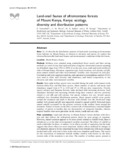| dc.description.abstract | Aims To (1) describe the distribution patterns of land-snails occurring in afromontaneforest habitats on Mount Kenya, in relation to elevation and aspect; (2) explore therelations between the land-snail faunas and environmental conditions within the forests.Location Mount Kenya, Kenya.Methods Molluscs were sampled using standardized direct search and litter sievingmethods in a total of sixty-four replicated plots along four elevational transects spanningan altitudinal range from 1782 to 2851 m on the east, west, south and north-northwestsides of Mount Kenya. Elevation, vegetation type, forest structure, soil calcium, soil pH,mean annual rainfall and other environmental variables were measured on each plot.Correlation and joint regression analysis, and canonical correspondence analysis (CCA)were used to relate snail diversity and abundance, and faunal composition, to siteelevation and other environmental variables.Results Sixty-eight mollusc species were recorded during the study with transect totalsbetween thirty-four and ®fty-three species. Mean number of species and mean snailabundance ranged from 6.75 to 23.0 and 19 to 348 per plot, respectively. Overall,species richness and Shannon diversity index declined with increasing elevation. Snailabundance declined with increasing altitude along three transects and was positivelyrelated to soil pH and soil calcium, but species richness was not. Several speciesexhibited clear altitudinal distribution patterns. Mean annual rainfall varies greatlyaround the mountain and tends to decrease with altitude over the elevational rangestudied. Soil calcium and pH were negatively related to annual rainfall. Estimated meanannual rainfall accounted for the greatest variation in the mollusc fauna around themountain. Faunas in forests on the drier, western side of Mount Kenya contained highernumbers of species in families that are characteristic of temperate latitudes, whereastropical families were more prevalent on the wetter, south and east sides.Main conclusions Land-snail diversity in Mount Kenya's forests declines with eleva-tion and thus follows the widespread pattern shown by most groups of organism.However, faunal variation appears to be more closely related to rainfall levels, than toaltitude per se or the other environmental variables examined. The effects of rainfall onsnails could either be direct, or indirect via its effects on soils or vegetation, but the studysuggests that direct effects are more important. Indirect effects mediated by changes insoil chemistry appear to be less important because lower altitude sites with more stronglyleached and acidic soils tend to have richer and more abundant snail faunas. The reasonfor the association of temperate latitude mollusc families with forests on the drier,western sides of the mountain is not clear. The number of mollusc species present in Mount Kenya's forests is broadly comparable with that reported elsewhere in EastAfrican forests. However, overall, the data from this study and elsewhere in East Africamay provide tentative evidence for a maximum level of land-snail richness atintermediate elevations of about 1000±1500 m. | en_US |

